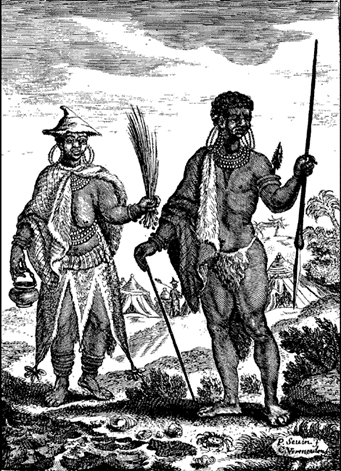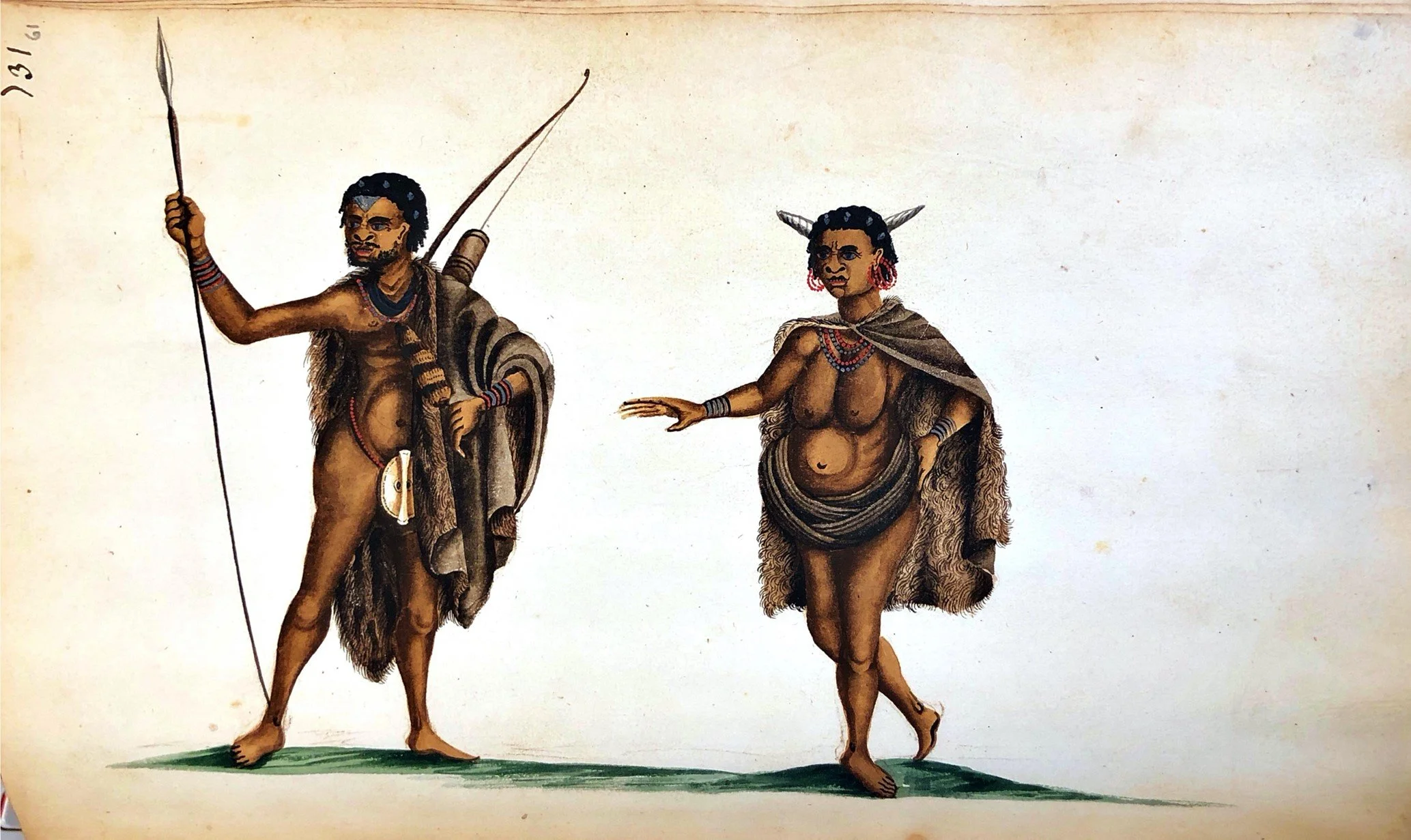Early modern racialisation in southern Africa
Histories of race in South Africa focus predominantly on the twentieth-century Apartheid period, when a minoritarian white supremacist government brutally enforced racial segregation. However, attempts to construct, classify, and exploit racial differences in the region stretch back to the Dutch East India Company’s establishment of the Cape Colony in 1652. Settlers wrote extensively about the Cape’s Indigenous populations, generally referring to them as “Hottentots”—now considered a derogatory term—on account of the sound of their language. For many centuries, Europeans characterised “Hottentots” as the vilest people in the world. Indeed, they came to embody the antithesis of civilisation, to the extent that the term “Hottentot” became a common insult with which to tar boorish and uncouth Europeans.
Figure 1: Cape "Hottentots" engraved by Pierre-Paul Sevin and Cornelis Vermeulen for Guy Tachard’s Voyage de Siam (1686), based on a drawing by Hendrik Claudius.
Despite Europeans’ hatred of the Indigenous inhabitants of the Cape peninsula, many maintained that the “Hottentots’” alleged incivility must have been counterbalanced a profoundly civilised population nearby. Based on rumours from Portuguese sailors and Jan Huygen van Linschoten’s Itinerario (1596), several settlers became convinced that a mythical gold-filled Kingdom called Monomotapa lay to the north of the colony. During Jan Van Riebeeck’s tenure as Commander of the colony (1652-62), the Goringhaicona go-between Krotoa (c. 1643-74) lent the idea credibility, informing settlers of a God-fearing, house-dwelling, copper-mining, “whitish” population “with long hair” in the north. Spurred by Krotoa’s reports, settlers launched several expeditions deep into the northern interior, in search of mineral wealth and “civilised” trading partners. Although they never did find Monomotapa, several inland journeys resulted in fleeting encounters with the Namaquas, whose elaborate metal jewellery and lighter skin colour led Europeans to believe they may have been related to the elusive Monomotapans. One such expedition, led by Simon Van der Stel in 1685, produced detailed descriptions of the Indigenous peoples encountered, contributing to early race-making in southern Africa.
The expedition’s journal, held in the Trinity College Dublin Library, consists of a report of Van der Stel’s expedition followed by 71 watercolour paintings interspersed with written descriptions of local naturalia. The vibrant images were painted by the Silesian apothecary Hendrik Claudius (1655-97), who had travelled to the East Indies before settling at the Cape in 1682. A passing Jesuit missionary, Guy Tachard (1651-1712), remarked that Claudius “draws and paints animals and plants to perfection.” The expedition’s journal reveals the subtle ways in which European settlers sought to describe, divide, and ultimately exploit the various Indigenous populations of southern Africa.
The expedition’s make-up was itself multi-ethnic. As the journal reveals, the travellers comprised “57 white men, … Dain Mangale, or [the] prince of Macasser [sic], with his servant, and three black servants.” The fact that the chronicler deemed it important enough to note the racial constitution of the group at the start of the account suggests how crucial such concerns were for seventeenth-century white Cape settlers. As the explorers travelled northwards hoping to find Monomotapa, they encountered other Indigenous groups and commented on their various cultural and physical features.
The voyagers were familiar with the Cape peninsula’s pastoralist “Hottentots” (Khoekhoen), who subsisted on meat from their herds. However, they soon came across less familiar nomadic “Sonquas” (San), who instead were hunter-gatherers. As the journal notes, the expedition met five “Hottentots… [who] said they were Sonquas or Obiquas, and they had come here to look for an eland which they had shot with poisoned arrows the day before.” The settlers established that the Sonquas “have no cattle, living on honey and the wild animals they shoot.” The journal commented on their physical appearance too, noting that “Their skin was very rough and scurvy owing to the frequent hunger they endure and the lack of fat with which to smear themselves.” This last observation directly contrasted them with the Cape “Hottentots,” who were instead known to spread rendered animal fat all over their bodies. A fortnight later, the author noted that “these Sonquas are just the same as the poor in Europe, each tribe of Hottentots having some of them and employing them to bring news of the approach of a strange tribe.” Later, once the expedition reached Namaqualand, the journal described “wandering Sonquas, [who] are subjects of the [N]Amaquas.” With such observations, settlers sought to integrate the unfamiliar “Sonquas” into European frameworks of social hierarchy, justifying their exploitation by all others. Thus, the racialisation of the “Sonquas” entailed defining their labour relations with other groups.
Figure 2: Namaqua man and woman, painted by Hendrik Claudius in the TCD MS IE 984 f. 61.
On 21 September, the expedition encountered “a kraal [village] of Hottentots, viz. Grigriquas,” who over the next few days “brought… their milk and some cattle to exchange.” Realising the importance of the Grigriquas as strategic victuallers, Van der Stel “laboured to convince them that they were very wrong… to wage war on one another, seeing that they were a small tribe and that other Hottentots could rob them all the more easily of their cattle.” Thus, the settlers created a hierarchy of ethnic groups, depending on what goods and services they were able to offer them.
Eventually, in October the expedition encountered the Namaquas, but found them to subvert all expectations. Claudius painted an image of a Namaqua couple, illustrating their clothing and unique physical features. An accompanying description tells us that the “Namaquas belong to the Hottentot race and live at 29°31’ south latitude, but they have no fixed abode.” It describes their distinctive, gendered apparel: the “men wear an iron plate on their foreheads… the skins of dassies, jackals and wild cats,” while the women “wear on either side of the head a sharp pointed oval piece of ivory fastened in their hair; in their ears and round their neck, stomach, and arms they wear red and black beads.” The journal further comments on the Namaquas’ physical characteristics, explaining that “they are lighter in colour and cleaner in body than the Cape Hottentots, of equal stature though with clumsy, heavy buttocks.” It elaborates certain aspects of their character, and—perhaps projecting the settlers’ frustration at the Namaquas’ difference from the expected “whitish,” God-fearing, “civilised” Monomotapans—notes that “they seem to fear nothing except thunder and lightning. They are very mendacious and deceitful.”
Such descriptions of both the physical features and cultural mores of different Indigenous populations constituted one of the earliest efforts to racialize southern Africans; a process with a dark and lengthy legacy stretching well into the late twentieth century.
Gianamar Giovannetti-Singh
Gianamar is a Freer Prize Fellow of the Royal Institution and the incoming Lumley Junior Research Fellow in History at Magdalene College, Cambridge and a Leverhulme Trust Early Career Fellow in the Faculty of History, University of Cambridge (2023-26).
Primary sources used
“Simon van der Stel's Journal of his Expedition to Namaqualand,” TCD MS IE 984, Trinity College Dublin Library
Guy Tachard, Voyage de Siam (Paris, 1686)
Further reading
Nicholas Hudson, “‘Hottentots’ and the Evolution of European Racism,” Journal of European Studies 34(4) (2004), 308-332.
Robert Bernasconi, “Silencing the Hottentots: Kolb’s Pre-Racial Encounter with the Hottentots and its Impact on Buffon, Kant, and Rousseau,” Graduate Faculty Philosophy Journal 35(1/2) (2014), 101-124.
Gilbert Waterhouse, “Simon van der Stel's Expedition to Namaqualand, 1685,” The Geographical Journal 64(4) (1924), 298-312.


